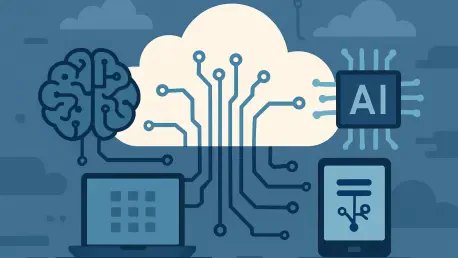The convergence of cloud computing and artificial intelligence (AI) has emerged as a transformative force in enterprise technology, yet a staggering 74% of organizations report significant delays and challenges during implementation, highlighting a critical paradox. While these technologies promise unparalleled efficiency and innovation, their adoption often stumbles over complex hurdles. This review dives deep into the intricacies of integrating cloud and AI solutions, examining their core features, persistent challenges, and real-world impact across industries. By dissecting performance metrics and emerging trends, the analysis aims to shed light on how enterprises can navigate the rocky path to successful deployment.
Core Features and Capabilities
Cloud computing offers scalable infrastructure that enables businesses to store, process, and access data remotely, reducing the need for on-premises hardware and providing flexibility in resource allocation. Its key components include public, private, and hybrid models, each tailored to specific organizational needs for cost efficiency and security. Paired with AI, which leverages algorithms and machine learning to analyze vast datasets and automate decision-making, the synergy allows for predictive analytics, personalized customer experiences, and operational optimization. Together, these technologies empower enterprises to handle dynamic workloads and drive data-driven strategies.
Beyond scalability, the integration facilitates real-time collaboration and innovation by allowing seamless updates and access across global teams. AI models hosted on cloud platforms can process information faster, benefiting from the immense computational power that on-demand servers provide. This combination also supports advanced applications like natural language processing and image recognition, which are increasingly critical in competitive markets. The potential for continuous improvement through iterative learning further positions this duo as a cornerstone of modern digital transformation.
Implementation Challenges
Skills Shortage in Architectural Design
A significant barrier to successful deployment lies in the scarcity of expertise, with 56% of enterprises identifying a lack of skilled architects as a primary obstacle. Designing systems that effectively integrate cloud infrastructure with AI algorithms requires specialized knowledge that many organizations simply do not possess. Without professionals capable of aligning technical frameworks with business objectives, projects often stall in the planning phase, unable to progress until the right talent is secured.
This gap extends beyond mere technical know-how, encompassing an understanding of how these technologies fit into broader enterprise goals. Many companies initially assume existing IT staff can adapt, only to discover that developers and operations teams lack the strategic vision needed for such complex integrations. Addressing this requires targeted training programs and strategic hiring initiatives to build internal capacity over time.
Misaligned Expectations and Cost Assumptions
Unrealistic expectations plague 69% of organizations, often driven by misconceptions about the cost-saving potential of cloud solutions and the immediate impact of AI tools. Senior management frequently anticipates significant expense reductions from cloud migration, overlooking hidden costs like data repatriation when applications are moved back on-premises due to unforeseen expenses. Similarly, AI is sometimes viewed as a quick fix for complex problems, leading to vague or overly ambitious project scopes that demand extensive reevaluation.
These misjudgments result in prolonged timelines as goals are redefined mid-project, a stark contrast to more predictable traditional IT endeavors. The accessibility of generative AI tools can exacerbate this issue, fueling proposals that clash with data security policies or lack feasible implementation paths. Bridging this disconnect necessitates clearer communication of limitations and a grounded approach to project planning from the outset.
Stakeholder Disalignment During Execution
The most prevalent challenge, affecting 74% of enterprises, occurs when stakeholders question the project direction during active implementation, revealing deep divides between IT and business perspectives. IT teams typically focus on integrating cloud and AI into existing workflows, prioritizing functionality and compatibility. Conversely, business managers often expect these technologies to deliver insights or interactive capabilities, leading to friction when outcomes do not match initial visions.
Such mid-execution reassessments cause substantial delays as compromises are negotiated, whether adjusting AI systems for managerial oversight or recalibrating cloud budgets after cost miscalculations surface. Real-world examples include projects halted during testing phases due to unexpected expenses or functionality gaps. Mitigating this requires early and ongoing alignment sessions to ensure all parties share a unified understanding of project aims and technical constraints.
Performance Metrics and Industry Impact
Analyzing performance, cloud and AI projects exhibit a failure rate nearly three times higher than traditional IT initiatives, with timelines often extending far beyond initial estimates. Despite this, successful implementations demonstrate remarkable gains, such as up to 40% improvement in operational efficiency for companies that manage to overcome early hurdles. Metrics like system uptime, processing speed, and cost per transaction highlight the potential for significant returns when deployment is executed with precision.
Across industries, the impact varies but remains profound. In healthcare, cloud-based AI systems enhance patient data analysis for faster diagnoses, while in finance, predictive models hosted on scalable servers improve fraud detection. Manufacturing benefits from automated quality control powered by machine learning, reducing defects and downtime. These use cases illustrate how tailored applications can drive sector-specific advancements, despite the rocky road to adoption.
Emerging Trends in Adoption Strategies
Current trends indicate a shift in how enterprises approach these technologies, with cloud practices showing greater maturity compared to the still-evolving understanding of AI applications. Organizations are increasingly recognizing the value of cross-functional teams dedicated to these projects, blending IT expertise with business insights to reduce missteps. Strategic partnerships with vendors also play a growing role, offering external guidance to navigate complex integration challenges.
Another notable development is the emphasis on organizational readiness, with companies investing in cultural shifts to better adapt to technological change. This includes fostering a shared language around AI and cloud concepts to prevent misunderstandings between departments. As adoption strategies evolve, there is a clear move toward proactive planning and skill-building, aiming to address barriers before they derail initiatives.
Barriers to Broader Acceptance
Despite their promise, several obstacles hinder widespread adoption, including technical limitations like data security concerns and interoperability issues. Regulatory constraints pose additional challenges, particularly in industries with strict compliance requirements, slowing down deployment as legal considerations are addressed. High initial costs and frequent miscalculations further deter smaller enterprises from taking the plunge, limiting market penetration.
Organizational readiness remains a critical factor, with many companies lacking the internal structure to support such transformative projects. Resistance to change among staff and leadership can exacerbate delays, as can the absence of clear success metrics to justify investment. Efforts to overcome these barriers include enhanced training, better cost forecasting tools, and advocacy for standardized regulations to ease compliance burdens.
Future Trajectory and Innovations
Looking ahead, advancements in integration tools are expected to simplify the melding of cloud and AI systems, reducing technical friction over the next few years from 2025 onward. More accessible AI frameworks are also on the horizon, potentially democratizing adoption for smaller players through user-friendly platforms. Innovations in cost management, such as dynamic pricing models, could further alleviate financial concerns, making these technologies viable for a broader audience.
The long-term outlook suggests a profound shift in how industries operate, with enhanced productivity and data-driven decision-making becoming standard. As skill development programs expand, the expertise gap may narrow, enabling more seamless implementations. These developments point to a landscape where cloud and AI not only coexist but redefine enterprise efficiency on a global scale.
Final Reflections
Reflecting on this evaluation, the journey of integrating cloud and AI technologies proves to be fraught with complexities, from skills shortages to stakeholder misalignments. Each challenge uncovered during the analysis highlights the steep learning curve enterprises face in harnessing these powerful tools. Yet, the transformative outcomes in successful cases underscore their undeniable value when obstacles are surmounted. Moving forward, organizations should prioritize building dedicated cross-functional teams to foster collaboration and invest in continuous education to close expertise gaps. Establishing robust planning frameworks that account for realistic costs and outcomes will be crucial, as will leveraging strategic partnerships to navigate uncharted technical terrain. These steps promise to pave the way for smoother adoptions, ensuring that the potential of cloud and AI is fully realized in shaping the next era of enterprise innovation.









